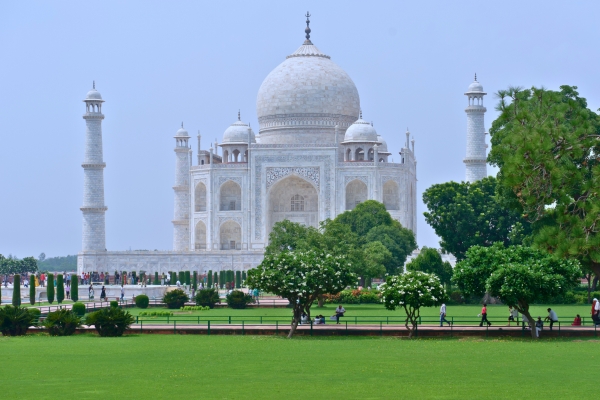Taj Mahal Travel Guide: Secrets, Stories, and the Magic of Eternal Love
September 20, 2025

Taj Mahal Travel Guide: Secrets, Stories, and the Magic of Eternal Love
The Taj Mahal is not simply a monument—it is an experience, a symbol, and a story woven into the very fabric of India’s history. Rising like a dream on the banks of the Yamuna River in Agra, this white marble monument has grabbed the imagination of poets, tourists, and lovers for centuries. Any Taj Mahal travel guide must begin with the awareness that this is not only a structure of stone but a living memory of commitment, artistry, and eternal love.
For millions who visit each year, the first glimpse of the Taj Mahal is breathtaking. Passing through the huge red sandstone entrance, the monument seems to float in the distance, glistening in the early morning light or gleaming under a brilliant sunset. It is said that no photograph, no matter how magnificent, can prepare you for the genuine moment when the Taj Mahal presents itself in perfect symmetry, mirrored in the water channels of its gardens.
The Taj Mahal was commissioned in 1632 by the Mughal emperor Shah Jahan in memory of his wife Mumtaz Mahal, who died giving birth to their fourteenth child. What began as a husband’s anguish became one of the greatest architectural masterpieces in the world, a site where love transcends time and stone seems to breathe with human passion.
Shah Jahan and Mumtaz: The Eternal Story
Every traveler who enters into the Taj Mahal walks into the stories of Shah Jahan and Mumtaz Mahal. Their marriage was not merely one of political alliance but also of profound personal attachment. Mumtaz accompanied Shah Jahan even on his military campaigns, bringing him advise and comfort.
In 1631, during the campaign in the Deccan, Mumtaz died while giving birth. Shah Jahan was saddened, withdrew from public life in sorrow. Chronicles tell us that his sadness was so overwhelming that his hair turned white in a couple of months. Out of this pain was born the dream of a monument so exquisite that it would keep her memory alive for eternity.
This is why the Taj Mahal is never merely perceived as an architectural wonder—it is felt as a love letter engraved in marble. Visitors often claim that standing before the tomb of Shah Jahan and Mumtaz Mahal feels like invading into the intimacy of love and grief, yet it is also a privilege to witness such devotion memorialized.
Architecture: Poetry in Stone
The Taj Mahal is the jewel of Mughal architecture, merging Persian, Indian, and Islamic traditions into a design of perfect harmony. The central dome rises magnificently to a height of nearly 73 meters, flanked by four minarets that tilt gradually outward—an engineering safeguard against earthquakes.
The white Makrana marble used in its construction was transported from Rajasthan, while semi-precious stones like jade, turquoise, lapis lazuli, and amethyst were inlaid into the marble using the method of pietra dura. The outcome is an amazing tapestry of flower motifs that seem to shimmer when sunlight strikes them.
The calligraphy adorning the entryway contains phrases from the Qur’an, crafted with such precision that letters look uniform to the human eye regardless of distance. Every element serves a purpose—whether symbolic, aesthetic, or practical—making the Taj Mahal not only gorgeous but also a marvel of design.
Travel writers have often equated the Taj Mahal to poetry. Some call it a love poem written in stone, others a frozen fantasy. The play of light across its surface alters its appearance throughout the day—rosy at sunrise, dazzling white at noon, golden at sunset, and ethereal under moonlight. For many visitors, visiting at different times of day feels like meeting the Taj Mahal anew each time.
The Gardens and the Yamuna River
The Taj Mahal is set inside a typical charbagh garden, inspired by Persian design, symbolizing paradise with its four quadrants split by water canals. Originally planted with fruit-bearing trees and aromatic flowers, the gardens produced a sensory experience of color, scent, and introspection. Though the layout today is simpler, the harmony and serenity remain.
Walking through the gardens, tourists generally feel a sense of peace before nearing the majesty of the tomb itself. The middle reflecting pool perfectly mimics the dome, creating one of the most photographed sights in the world. Yet for those who pause and breathe, the gardens give more than beauty—they prepare the soul for the encounter with eternity.
Behind the monument runs the Yamuna River, another significant part in the architecture. Its waters mirror the marble, providing the illusion of the Taj floating above the riverside. From across the river in Mehtab Bagh, the Taj Mahal appears tranquil and distant, a vision suspended between earth and sky.
Legends and Myths
No Taj Mahal travel guide is complete without the stories and myths that surround it.
One of the most popular traditions is that Shah Jahan planned to build a “Black Taj Mahal” on the opposite bank of the Yamuna as his own tomb, reflecting Mumtaz Mahal’s burial place. Though archaeological data does not corroborate this assertion, the tale remains, providing an aura of mystery to the monument.
Another common myth is that the craftsman who created the Taj Mahal were disfigured so they could never create anything as magnificent again. While historians consider this as fantasy, the legend reflects the amazement individuals felt—surely anything so exquisite could never be duplicated.
Local guides also relate legends of the Taj changing hues like a living being—blushing pink at sunrise, bright white by day, shimmering gold at nightfall, and silver beneath the moon. These beautiful pictures are part of the experience, converting the Taj Mahal into more than stone and mortar—into something alive.
The Taj in Literature and Memory
From the 17th century to today, the Taj Mahal has been a muse for poets and novelists. Mughal chroniclers equated it to heaven itself, while travelers from Europe wrote about it with awe. Rabindranath Tagore memorialized it as “a teardrop on the cheek of time,” reflecting its frail yet eternal beauty.
In colonial times, British officials hailed it both as a symbol of romance and as proof of India’s grandeur. Modern travel bloggers and writers continue the tradition, often conceding that words fall short of the true experience. The Taj Mahal has also become a global cultural emblem, appearing in films, literature, and even music as shorthand for love and loyalty.
Traveler Impressions: Voices Across Time
What unifies centuries of travelers is the emotion of awe upon visiting the Taj Mahal.
Seventeenth-century French traveler Jean-Baptiste Tavernier deemed it the most superb building ever built. British officers in the 19th century recalled their wives collapsing from emotion upon first sight. Today, online evaluations repeat the same wonder—despite the crowds, despite the images, the moment of first encounter remains amazing.
One traveler wrote: “I thought I was prepared. I had seen the Taj Mahal on postcards, in books, in films. But when I walked through the arch and saw it framed perfectly, shining in the morning light, I felt my heart stop. It was not just a building. It was a feeling.”
Another visitor described the hush that descended upon entering the tomb room, the gentle echo of footfall, and the exquisite lattice screens around the cenotaphs. “It felt as if the air itself was sacred,” they wrote.
These impressions demonstrate that the Taj Mahal is more than a destination. It is an encounter that leaves visitors with a memory imprinted as deeply as the inlaid stones on its walls.
Preservation and the Living Monument
Though it appears everlasting, the Taj Mahal is frail. Pollution from industries, river changes, and millions of visitors have endangered its marble with yellowing and damage. Conservation measures, such as clay-pack cleaning and environmental regulation, are underway.
Travelers who visit now are not only witnesses but also participants in its tale. Each ethical act—respecting the monument, limiting pollution, appreciating its sanctity—contributes to conserving the Taj Mahal for future generations.
The Taj is not a relic of the past but a living monument, treasured across centuries. For Shah Jahan, it was a monument to love. For the Mughals, it was a symbol of imperial supremacy. For modern India, it is a heritage jewel. For the world, it is a wonder—one of the few creations of humankind that feel touched by god.
